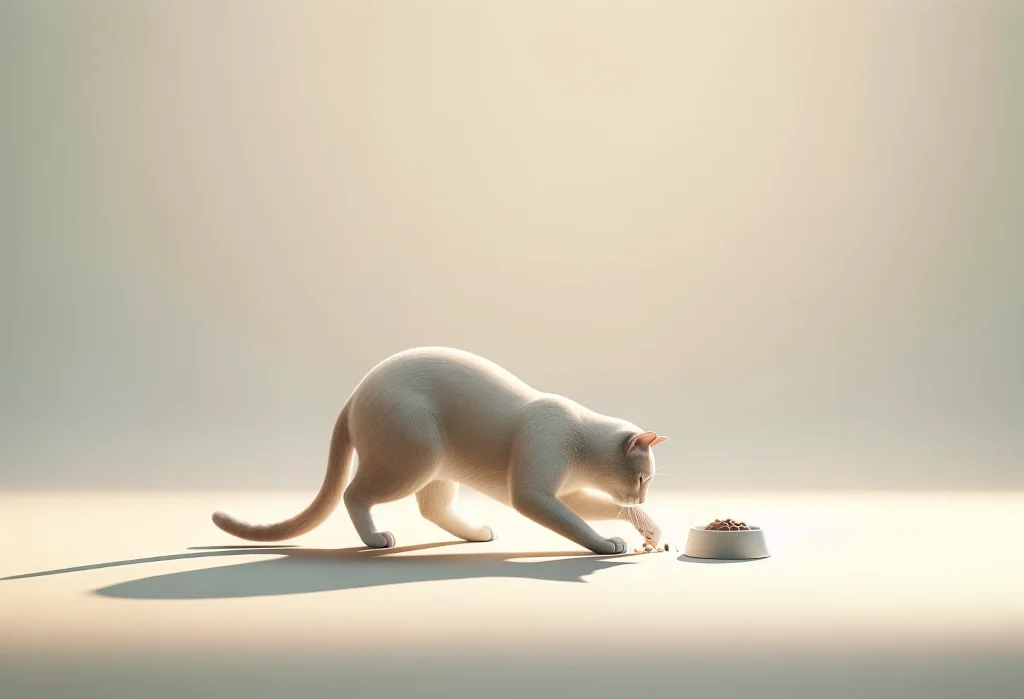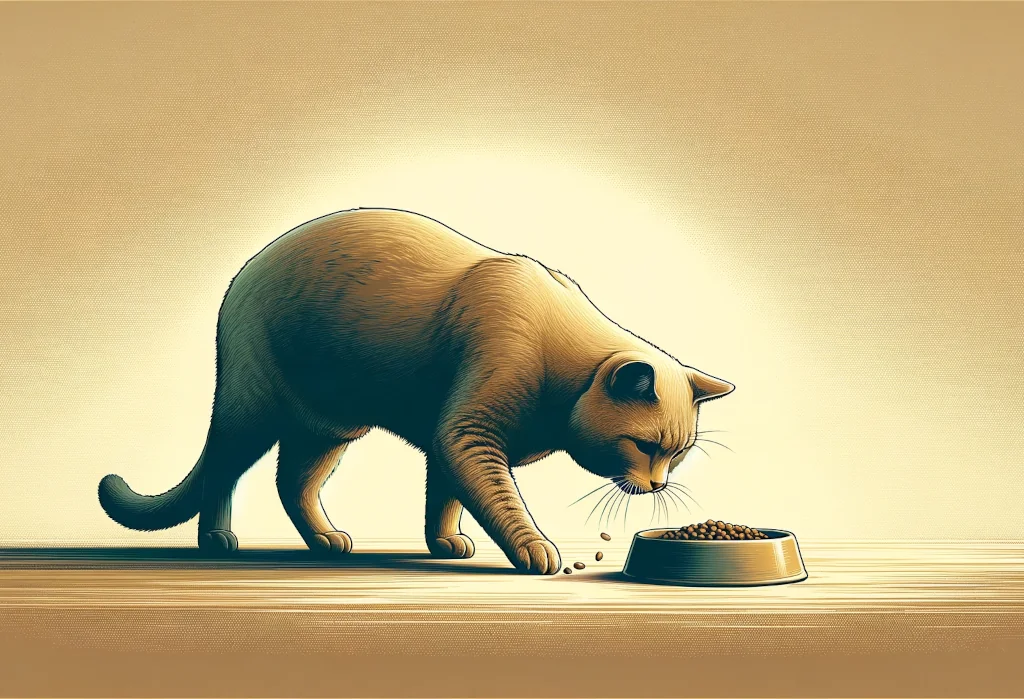
Have you ever noticed your cat engaging in the peculiar behavior of scratching the floor just after they’ve finished their meal? It’s a scene familiar to many cat owners, leaving us scratching our heads as much as our feline friends do the ground. This behavior, odd as it might seem, is not without reason and understanding it could bring you closer to unraveling the mysteries of your cat’s unique habits.
In this exploration, we dive into the why’s and how’s of your cat’s post-meal floor-scratching ritual. We promise insights that will not only satisfy your curiosity but also help foster an environment where both you and your furry companion feel understood and connected.
Quick Takeaways:
- Cats scratch the floor after eating due to instinctual behavior meant to hide food remnants and mark territory.
- Introducing a scratch mat or post near the feeding area can redirect this scratching behavior to a more suitable outlet.
- Excessive or distressed scratching can be a sign of underlying health or behavioral issues, warranting a vet visit.
Is This Behavior Common Among Cats?
Ever noticed your cat performing a mini excavation project on your kitchen floor after chowing down? If so, you’re far from alone. Many cat owners observe this peculiar behavior and wonder if their feline friend is the only kitty archaeologist around.
Rest assured, this habit is pretty widespread among the whiskered population. While not every cat will demonstrate this quirky behavior, it’s common enough that it’s not considered abnormal or a cause for concern. Cats are creatures of habit and mystery, and this floor-scratching ritual is just one of their many enigmas.
What’s Behind the Scratching?
To understand why your cat might be scratching the floor post-meal, it’s crucial to dive into the instinctual and psychological underpinnings of this behavior. Here are a few theories that shed light on this feline mystery:
- Instinctual Covering Behavior: In the wild, cats often bury their food remains to prevent attracting predators or rivals to their territory. Your domesticated kitty’s scratching might be an instinctive attempt to cover up their food, even though their bowl is safely indoors.
- Territory Marking: Cats have scent glands in their paws. When they scratch, they may also be marking their territory, letting other household pets know that this dining spot is claimed.
- Ancestral Instincts: Some experts suggest that this behavior can be traced back to their wild ancestors, who had to hide their food from scavengers. Although your home is a safe environment, these deep-rooted instincts can still influence your cat’s actions.
Understanding these reasons can provide insights into the rich tapestry of feline behaviors influenced by their wild ancestry and instinctual drives.

What Does This Mean for Your Home?
Now that you know your cat’s floor-scratching saga is part of their mysterious cat charm, what does this mean for your living space?
Firstly, it’s important to interpret this behavior in a broader behavioral context. If your cat exhibits this behavior infrequently and doesn’t show signs of distress, it’s likely just a harmless quirk. However, obsessive or sudden changes in behavior might warrant a vet visit to rule out any underlying issues.
Protecting Your Floors
To safeguard your floors from enthusiastic paws, consider these tips:
- Provide an Alternative: Offer a scratch-friendly surface near their eating area. A small, cheap rug or a scratch mat can serve as a suitable outlet for their scratching instincts.
- Deterrent Sprays: Though opinions on their effectiveness vary, using a mild deterrent spray around the eating area might discourage floor scratching. Choose cat-friendly options available in pet stores.
- Regular Nail Trims: Keeping your cat’s claws trimmed can minimize the potential damage to your floors. However, always approach nail trimming with care or seek professional grooming help if needed.
A Unique Insight:
A rarely discussed but highly effective strategy is to use a feeding puzzle. These devices not only slow down your cat’s eating but also engage their mind, potentially reducing the urge to scratch as a post-meal activity. Feeding puzzles tap into your cat’s predatory instincts in a constructive way, possibly mitigating some of the instinctual behaviors linked to their wild counterparts.
By understanding why cats scratch the floor after eating and taking proactive steps to accommodate or gently modify this behavior, you can keep your living space intact and maintain harmony in your home. Remember, every cat’s individuality is what makes them such fascinating and beloved companions.
Can You Redirect This Behavior?
Absolutely, it’s possible to harness your feline friend’s scratching instincts into more acceptable avenues. Cats scratch after eating for various reasons, from marking their territory to simply stretching. However, when the dining area becomes their favorite scratching post, it might be time to intervene for the sake of your floors.
Here are a few strategies to guide your cat towards more scratch-friendly behaviors:
-
Introduce Scratch Posts/Pads Near the Feeding Area: Place scratch-appropriate materials close to where your cat eats. This doesn’t mean right next to their food bowl, but in the vicinity. Cats like options, so consider different textures and types of scratching posts or pads, such as sisal fabric, cardboard, or carpeting. This gives them a proper outlet for their scratching urge post-meal.
-
Use Feline Pheromones: Products containing feline pheromones or catnip can attract your cat to the scratch post. Sprinkling some catnip on the posts or using a pheromone spray can make the scratching post more enticing than the floor.
-
Training and Positive Reinforcement: Every time your cat uses the scratch post after eating, offer them a treat and some praise. Positive reinforcement will help them make the connection between the desirable behavior and a tasty reward.
-
Gradient Change: If your cat is stubborn, slowly move the feeding bowl closer to the preferred scratching area over time. This gradual change can help them associate the act of scratching with the new, more appropriate location.
Unique Insight: Consider a “scratching mat” as a placemat for the food bowl. These are less intrusive than full posts and can blend into your home decor more seamlessly. Some cats may start by scratching these mats instead of the floor, bridging their natural behavior with the human need for unscratched floors.
When Should You Be Concerned?
While scratching is a natural behavior for cats, there are times when it could signal something more concerning than just a quirky habit.
Be on the lookout for:
-
Excessive Scratching Without Relief: If your cat is obsessively scratching the same spot or seems to be doing so in distress, it might be time for a vet visit. This could indicate skin issues, allergies, or other discomforts needing medical attention.
-
Changes in Behavior or Appetite: If the floor scratching is accompanied by a decrease in appetite, lethargy, or other sudden changes in behavior, it warrants a deeper look. Cats are adept at hiding illnesses, so behavior changes can be a subtle sign something’s off.
-
Scratching Accompanied by Other Destructive Behaviors: If the floor scratching escalates to other destructive behaviors or your cat seems agitated, consult with a veterinarian or a feline behaviorist. Stress, anxiety, or underlying health issues could be at play, and it’s essential to address these concerns early on.
In conclusion, while it’s perfectly normal for cats to scratch after eating, keeping an eye on where and how often this occurs is crucial. Redirecting this behavior to a more appropriate outlet can save your floors and offer your cat a satisfying scratching experience. However, don’t hesitate to seek professional advice if you sense the scratching could be symptomatic of a larger issue. Remember, your kitty’s well-being is always the top priority.
Alex, a passionate animal lover, has experience in training and understanding animal behavior. As a proud pet parent to two dogs and three cats, he founded AnimalReport.net to share insights from animal experts and expand his knowledge of the animal kingdom.




